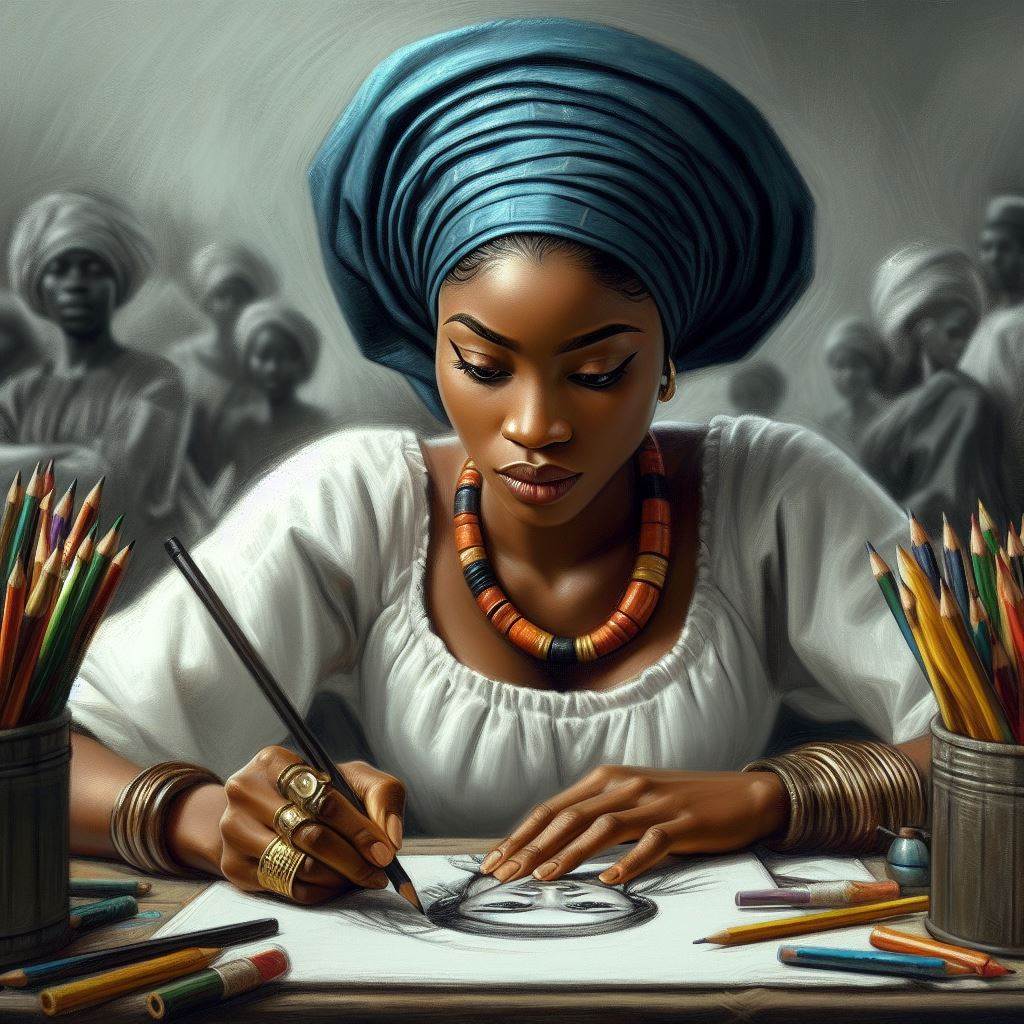Introduction
Building a portfolio in fine and applied art is crucial for any artist, whether emerging or established.
A strong portfolio showcases an artist’s skills and talents effectively, acting as a visual resume.
It allows artists to present their best work to potential clients or employers, demonstrating their unique style and technical proficiency.
A well-curated portfolio highlights an artist’s versatility and ability to handle various artistic challenges.
For emerging artists, a compelling portfolio can open doors to exhibitions, commissions, and collaborations.
It serves as a tangible testament to their creative journey and achievements, providing a snapshot of their artistic evolution.
Moreover, a portfolio is a dynamic tool that evolves with the artist.
As new works are created and artistic directions change, the portfolio grows, reflecting the artist’s continuous development.
By investing time and effort into creating a comprehensive portfolio, artists position themselves for greater opportunities and success in their careers.
Ultimately, a portfolio is an essential tool for artists to communicate their vision, passion, and dedication to their craft.
It enables them to share their work with a broader audience, gaining recognition and appreciation for their art.
A thoughtfully designed portfolio can be the key to unlocking new pathways in the art world, fostering connections, and inspiring others.
Research and Planning
Research Different Styles and Techniques in Fine and Applied Art
To build a portfolio in fine and applied art, start by researching different styles and techniques.
Understanding diverse styles helps you decide what to showcase in your portfolio.
Study renowned artists and their approaches to gain insights and inspiration.
Experiment with various techniques to discover what resonates with your artistic voice.
Explore traditional and contemporary art forms to find your niche.
Fine art encompasses painting, drawing, sculpture, and more.
Applied art includes graphic design, fashion, ceramics, and industrial design.
Identify the mediums that best express your creativity.
Once you have a clear understanding, select the styles and techniques that highlight your strengths.
Choose works that reflect your versatility and skill.
Your portfolio should demonstrate your range, from realistic to abstract, or from minimalist to complex designs.
Plan Out the Structure and Format of Your Portfolio
Plan the structure and format of your portfolio carefully.
Decide if it will be physical, digital, or both.
A physical portfolio works well for face-to-face meetings, while a digital portfolio reaches a wider audience.
Ensure your digital portfolio is easily accessible on various devices.
Organize your portfolio logically:
- Start with a strong piece to capture attention immediately.
- Follow with works that show progression and depth.
- Group similar styles together to create a cohesive flow.
- Highlight your best works, but also include pieces that show your development.
Essential Tips for Presentation and Success
Consider the layout and presentation
Use high-quality images that accurately represent your work.
If you have 3D pieces, include multiple angles.
For digital formats, ensure images load quickly without compromising quality.
Include detailed descriptions for each piece.
Explain your inspiration, process, and materials used.
This context adds depth and helps viewers connect with your work.
For applied art, describe the functionality and design thinking behind your pieces.
Balance is crucial.
Avoid overcrowding your portfolio with too many works.
Aim for a selection of 10-20 pieces that showcase your best and most relevant work.
Each piece should add value and demonstrate your abilities.
Customize your portfolio for different audiences.
Tailor it to the type of opportunities you seek.
For job applications, align your portfolio with the company’s style and values.
For galleries or exhibitions, focus on works that fit their curatorial themes.
Keep your portfolio updated.
Replace older pieces that no longer represent your current skill level with new works.
Regular updates show your growth and ongoing commitment to your art.
Seek feedback from peers, mentors, or industry professionals.
Constructive criticism helps refine your portfolio and make it more impactful.
A well-crafted portfolio not only showcases your talent but also opens doors to new opportunities in the art world.
Read: Comparing Communication Arts and Mass Communication
Selecting and Organizing Work
- Choose a variety of your best artworks that demonstrate your range and skills.
- Consider selecting pieces that showcase different mediums, techniques, and subject matters to highlight your versatility.
- Include both finished pieces and works-in-progress to demonstrate your process and development as an artist.
- Ensure that each artwork in your portfolio is of high quality and reflects your unique artistic voice.
Organize your selected pieces in a cohesive and visually appealing way within your portfolio.
Organizing your selected pieces in a cohesive and visually appealing way within your portfolio is crucial for making a strong impression on viewers.
Here are some tips on how to effectively structure your portfolio:
- Start with a captivating introduction that gives viewers a glimpse into your artistic journey and background.
- Arrange your artworks in a logical sequence that flows well and tells a cohesive story about your skills and interests.
- Consider grouping similar pieces together to create a cohesive visual narrative within your portfolio.
- Pay attention to the overall layout, spacing, and design of your portfolio to ensure a polished and professional presentation.
- Include brief descriptions or artist statements for each artwork to provide context and insight into your creative process.
By carefully selecting and organizing your work, you can create a portfolio that effectively showcases your talent, skills, and unique artistic vision to potential clients, employers, or art institutions.
Read: Language Arts Courses: What to Expect in Nigeria
Including Artist Statement
Write a Concise Artist Statement
Writing a concise artist statement is crucial for explaining your artistic vision, influences, and goals.
Start by reflecting on what drives your creativity. Consider the themes and ideas that you explore in your work.
This reflection helps you articulate your artistic vision clearly and compellingly.
Describe the influences that shape your art. Mention specific artists, movements, or personal experiences that inspire you.
Explaining your influences gives context to your work and helps viewers connect with your artistic journey.
State your artistic goals. Whether you aim to provoke thought, evoke emotions, or explore certain concepts, your goals define the purpose of your art.
This clarity helps viewers understand the intention behind your creations.
Keep your artist statement concise. Aim for around 100-150 words, focusing on the essence of your artistic practice.
Avoid jargon and overly complex language. Instead, use clear and engaging sentences that invite readers to explore your work further.
Include Your Artist Statement in Your Portfolio
Including your artist statement in your portfolio gives viewers a deeper understanding of your work.
Place it at the beginning of your portfolio to set the stage for what follows.
This introduction helps viewers appreciate the context and meaning behind your art.
Ensure your artist statement is well-presented.
Use a clean, readable font and format it neatly.
For physical portfolios, print it on quality paper.
For digital portfolios, ensure it is easily accessible and legible on various devices.
Pair your artist statement with a professional photo of yourself.
This personal touch helps establish a connection with your audience.
A well-written artist statement combined with a strong visual presence enhances the overall impact of your portfolio.
Regularly update your artist statement to reflect your evolving artistic journey.
As your work and influences change, so should your statement.
Keeping it current ensures it remains relevant and authentic.
Seek feedback on your artist statement from peers and mentors.
Constructive criticism can help refine your message and improve its clarity.
A well-crafted artist statement not only explains your work but also engages and inspires your audience.
Writing a concise artist statement is essential for conveying your artistic vision, influences, and goals.
Including it in your portfolio enriches the viewer’s experience and understanding of your work.
A clear, engaging artist statement can make your portfolio more impactful and memorable.
By regularly updating your statement and seeking feedback, you ensure it continues to represent your evolving artistic practice accurately.
Read: Communication Arts: Job Prospects and Salaries

Adding Process Work
Include sketches, drafts, and progress photos to show your creative process and development as an artist
When building a portfolio in fine and applied art, it’s crucial to include process work alongside your finished pieces.
This behind-the-scenes look at your creative process not only adds depth to your portfolio but also showcases your artistic evolution.
Here’s why and how you should incorporate process work into your portfolio:
Importance of Process Work
Process work provides insight into your artistic journey and demonstrates your thought process and decision-making skills.
It shows potential clients and employers how you approach a project from start to finish, shedding light on your creativity and problem-solving abilities.
Including process work in your portfolio can set you apart from other artists and give viewers a deeper understanding of your work.
Types of Process Work to Include
There are several types of process work you can incorporate into your portfolio:
- Sketches: Initial sketches can reveal your initial ideas and concepts for a piece.
- Drafts: Progressively refined drafts show how your artwork evolves over time.
- Progress Photos: Images documenting the stages of your work can provide a visual timeline of your creative process.
How to Showcase Your Process Work
When adding process work to your portfolio, consider the following tips:
- Organize: Arrange your process work in a clear and logical sequence to show the progression of your work.
- Label: Provide captions or descriptions for each piece of process work to explain its significance and relevance to the final artwork.
- Visual Variety: Include a mix of sketches, drafts, and progress photos to offer a comprehensive view of your creative process.
- Context: Connect your process work to the finished artwork by highlighting how each step contributed to the final piece.
By incorporating process work into your portfolio, you can offer viewers a glimpse into your artistic journey and showcase your skills and creative evolution.
Remember to update your process work regularly to reflect your growth as an artist.
Read: How to Apply for Communication Arts Programs
Digital Presentation
Create a digital version of your portfolio for online viewing and sharing
In today’s digital age, having a strong online presence is essential for artists looking to showcase their work and attract potential clients.
One of the best ways to achieve this is by creating a digital version of your portfolio.
By doing so, you can easily share your work with a global audience and make a lasting impression.
Benefits of Digital Presentation
- Accessibility: A digital portfolio allows people to view your work anytime, anywhere, with just a few clicks.
- Shareability: You can easily share your portfolio via email, social media, or your own website, reaching a larger audience.
- Interactivity: Digital portfolios can include multimedia elements such as videos, animations, and interactive features to engage viewers.
- Professionalism: Having a well-designed digital portfolio showcases your work in a professional and polished manner, leaving a lasting impression on potential clients.
Utilize platforms like websites or social media to reach a wider audience and potential clients
- Choose a Platform: Decide whether you want to create a standalone website, use social media platforms, or utilize online portfolio services.
- Organize Your Work: Categorize your projects into different sections and showcase a variety of styles and mediums to demonstrate your versatility.
- High-Quality Images: Use high-resolution images of your artwork to ensure that the quality is not compromised when viewed online.
- Description and Context: Provide a brief description or background information for each piece to give viewers a better understanding of your process and inspiration.
- Contact Information: Make it easy for potential clients to get in touch by including your contact information or a contact form on your digital portfolio.
- Regular Updates: Keep your digital portfolio up to date with your latest work and projects to show that you are active and constantly evolving as an artist.
- Social Media Integration: Share your portfolio on social media platforms to drive traffic and attract new followers who may be interested in your work.
By following these tips and utilizing the power of digital presentation, you can effectively build a strong portfolio in fine and applied art that will help you stand out in a competitive industry.
Remember, your digital portfolio is a reflection of your creativity and talent, so make sure to showcase your best work in the most captivating and professional manner possible.
Seeking Feedback
Share Your Portfolio with Trusted Peers, Mentors, or Art Professionals
Sharing your portfolio with trusted peers, mentors, or art professionals is crucial for gaining valuable feedback.
These individuals can provide diverse perspectives and insights that you might not see yourself.
By exposing your work to different eyes, you can identify areas for improvement and strengths you may not have recognized.
Select people who have a good understanding of your artistic field.
Trusted peers can offer constructive criticism based on shared experiences and knowledge.
Mentors bring a wealth of experience and can guide you with their seasoned advice.
Art professionals, including curators and gallery owners, can offer industry-specific insights that enhance your portfolio’s appeal.
When presenting your portfolio for feedback, provide context.
Explain your artistic vision, goals, and any specific concerns you have.
This background helps reviewers provide targeted and useful feedback.
Encourage honest and specific critiques rather than general comments.
Use Their Suggestions to Improve and Refine Your Portfolio
Use the feedback from your trusted reviewers to improve and refine your portfolio.
Analyze the suggestions carefully, and consider how they align with your artistic vision and goals.
Some feedback may be immediately applicable, while other advice might require deeper reflection.
Start by addressing the most critical points first.
If multiple reviewers point out the same issue, prioritize that area for improvement.
Common suggestions might include reorganizing the layout, improving the quality of your images, or adding more context to your descriptions.
Make changes gradually and thoughtfully.
Implement one suggestion at a time, then reassess your portfolio to see how the changes affect the overall presentation.
This methodical approach ensures that each adjustment enhances your portfolio without disrupting its coherence.
Seek additional feedback after making significant changes.
Sharing your updated portfolio with the same or new reviewers helps validate your revisions and uncover any remaining issues.
Continuous feedback loops ensure that your portfolio remains dynamic and continually improves.
Balancing feedback with your artistic integrity is key.
While external suggestions are valuable, your portfolio should still reflect your unique artistic voice and vision.
Selectively incorporate feedback that enhances your work without compromising your personal style.
Sharing your portfolio with trusted peers, mentors, or art professionals provides essential feedback to enhance your work.
Use their insights to improve and refine your portfolio, making it more impactful and engaging.
A feedback-driven approach ensures your portfolio evolves and remains compelling.
Balancing external suggestions with your artistic integrity helps maintain your unique voice while continually improving your presentation.
By seeking and applying constructive feedback, you position yourself for greater success and recognition in the art world.
Conclusion
Building a fine and applied art portfolio requires careful curation and constant refinement.
Start by selecting your best work, showcasing a variety of skills and styles.
Organize your pieces thoughtfully, ensuring a cohesive and engaging presentation.
Include detailed descriptions, highlighting your creative process and the significance of each piece.
High-quality images are essential; invest in good photography.
Regularly update your portfolio to reflect your artistic growth and new achievements.
Seek feedback from peers and mentors to enhance your portfolio’s impact.
Stay current with trends and adapt your portfolio accordingly.
Keep exploring new techniques and mediums to diversify your work.
Your portfolio is a living document, evolving as you develop as an artist.
Consistent updates will demonstrate your progress and dedication.
Embrace change and let your portfolio tell the story of your artistic journey.
Keep pushing boundaries, and your portfolio will remain a powerful testament to your evolving creativity.
Celebrate every milestone and learning experience.
Each update to your portfolio marks a step forward in your artistic career.




